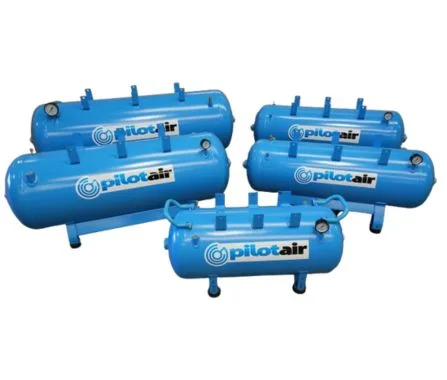
Air receiver tanks, or compressed air storage tanks, are an integral component of many compressed air systems, and they work to keep systems running optimally.
Storing compressed air for times of peak demand, the air receiver tank helps remove water from the system by allowing the air a chance to cool.
It also reduces any pulsation in the compressed air system caused by a reciprocating air compressor.
To ensure your system is working as efficiently and safely as possible, it is important that you have the right sized air receiver for your application, with adequate storage capacity.
“The right receiver tank size ensures smoother airflow, reduced energy costs, and longer compressor life.”

Considering your application
There are a number of factors to consider when determining the correct size compressed air storage tank for your application.
Firstly, your air compressor capacity – in cubic feet per minute (cfm) – will direct the storage capacity of your air receiver tank. Generally, you will require 5 – 10 litres of air storage capacity per cfm output. Your cfm requirements at moments of peak demand will also play an important role in deciding your compressed air tank size.
Factoring in the consistency of airflow for your application is also important when sizing your compressed air storage tank. Applications that have consistent air flow requirements will generally not require as much stored air.
As the air flow demand is fairly steady, there is less need to accommodate high bursts of demand that rely on stored air.
However, if your application has a high variability in air flow demands, with frequent peaks and troughs, you may require larger volumes of stored air.
Key Takeaways
Correct Sizing Prevents Issues
Properly sized tanks reduce compressor cycling, improve efficiency, and extend system life.
Match Capacity to Demand
Use 5–10 litres per CFM as a baseline, adjusting for peak loads.
Flow Variability Matters
Steady flow needs less storage, while variable demand benefits from larger tanks.
Compressor Type Impacts Size
Reciprocating units need bigger tanks; rotary screw models can operate with smaller ones.

Type of air compressor
The type of air compressor used in the application will also determine what size compressed air storage tank you require.
When used in conjunction with reciprocating air compressors, compressed air storage tanks not only store air, but eliminate pressure variations caused from the oscillatory flow patterns (known as pulsation). Because the air compressor can drain the tank of air if the storage capacity is inadequate, a properly sized tank can help reduce interruptions to air flow.
For custom-built compressed air systems, sizing of an air receiver tank is quite complex and should be done by an expert. Volume and pressure variations in air demand, air compressor size and the systems control centre will all play an important part in determining the size of the compressed air storage tank.
“Pilot Air storage tanks are built to Australian standards and trusted by Sydney industries.”

Extensive product range
Whether you have a custom-built air compressor or a catalogue product, Pilot Air’s extensive range of Australian made compressed air storage tanks offers a solution for all your needs, no matter the industry.
Our product range and large stock levels, combined with our comprehensive spare parts inventory, ensure we maintain your compressed air system’s reliability and efficiency while reducing whole-of-life operating costs.
Learn more about our compressed air products.





